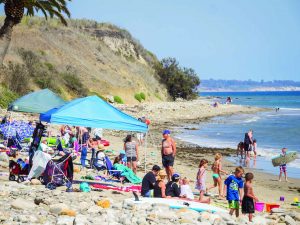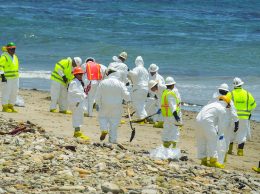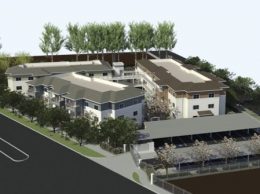3 months after oil spill, Santa Barbara region recovering
IN THIS ARTICLE
- Energy Topic
- pacbiztimes Author
By pacbiztimes Friday, August 14th, 2015

Crowds have returned to Refugio State Beach, which was tainted by an oil spill May 19. (Nik Blaskovich photo)
Even though Plains All American Pipeline underestimated the extent of the Refugio oil spill, Santa Barbara businesses and residents are feeling less of a sting than expected since the rupture fouled the Gaviota coastline and its wildlife about three months ago.
Plains, the Houston-based oil company responsible for the spill, said in a quarterly earnings report that the rupture could have released 3,400 barrels of crude, about 1,000 more than originally assessed.
Line 901, the 29-year-old pipe that leaked, runs from Gaviota to Las Flores Canyon and can transport 48,000 barrels a day. It has been shut down since May 19 and connects to Plains’ Line 903, which was halted on May 30.
Plains CEO Greg Armstrong estimated the spill was a $257 million blunder, which factors in the emergency response and cleanup efforts as well as expected legal claims and potential settlements. It does not include any lost revenue from its pipeline shutdowns.
But the company would only shoulder $65 million of the $257 million because insurance would cover the rest, Armstrong said in the earnings report.
While there’s plenty left to play out, including proposed legislation demanding better oil spill response and prevention measures, lawsuits to make their way through the courts, claims, potential fines and penalties to be levied, and habitat restoration quantified and carried out, many in the region say it could’ve been a lot worse.
“Although several businesses anecdotally reported being affected (such as a few tour operators based directly on the Gaviota Coast and a few restaurants), hard data appears to indicate that there has not been a significant decline in overall tourism due to the oil spill,” Visit Santa Barbara Communications Manager Jaime Shaw told the Business Times.
Media reports portrayed doom and gloom immediately after the spill, dissuading would-be vacationers during one of the most popular holidays. Santa Barbara commercial fishermen had a tough time selling what they could catch outside of the 138 square miles of fisheries that were closed because people thought all of the region’s seafood was tainted.
Business owners thought tourism, the lifeblood of Santa Barbara’s economy, would take a long time to fully recover.
But nearly three months later, tourists’ cancellations were mostly offset by the thousands of employees tasked with cleaning the spill.
The fisheries ban was lifted after six weeks, about a month earlier than expected, after the Office of Environmental Health Hazard Assessment found that the area’s seafood was safe to eat and posed “no significant health threat.”
As soon as campgrounds at El Capitan and Refugio state beaches reopened, they were completely booked through the summer.
A prominent hotelier in Santa Barbara, who wished to remain anonymous, told the Business Times that the oil spill was a boon for many businesses and hotel owners.
While the spill has translated to more revenue for emergency responders like Aspen Helicopters, an Oxnard-based helicopter touring company, some fishermen and restaurants have adjusted their businesses to accommodate short-term revenue loss.
Fishing industry recovers
Several lawsuits filed on behalf of local fishermen claim they’ve incurred profound economic impacts due to the fisheries closure, negative perceptions and fewer tourists who would be going on fishing charters, but many adjusted and recovered better than expected.
Santa Barbara commercial fishermen average $11 million in sales revenue per year, predominantly stemming from red sea urchin and red rock crab.
While those who fish in the affected area around the Gaviota Coast were temporarily hit hard, the relatively quick reopening of the fisheries, combined with the announcement that local seafood posed “no significant health hazards,” eased the pain, said Chris Voss, executive director of the Commercial Fishermen of Santa Barbara.
“Although the oil spill was confined to a finite area east of us, there were some who were significantly impacted in the fishing community,” he said. “But (the reopening and announcement) helped minimize the long-term overall economic impact.”
Still, fishermen won’t be able to foresee future issues, such as if the oil wiped out a main food source for certain sea life, Voss added.
David Goldenberg, executive director of the Santa Barbara-based California Sea Urchin Commission, said there was minimal impact.
“Not many sea urchins are harvested in that area,” he said.
A sushi chef at Sushi Teri said that his restaurant was forced to source sea urchin from Canada instead of Santa Barbara during the fisheries closure, which was more expensive. While the restaurant sold less sea urchin, business did not decrease, he said.
A federal court has extended the deadline for Plains to respond to the fishermen’s suits until early October, according to Matthew Preusch, an attorney at Keller Rohrback who is representing a sea urchin diver in a lawsuit against Plains.
Tourism numbers good
Some hotels in Santa Barbara County lost up to half of their reservations during Memorial Day weekend, but many in the business community either broke even or benefitted from the thousands of spill cleanup workers.
While it’s difficult to pinpoint the surges and drops in transient occupancy tax, the 12 percent levy the city collects from hotel owners increased 6.7 percent in June compared to last year.
Jeanette Webber, who manages several hotels in Santa Barbara, said it was lucky that the spill was labeled Refugio and was relatively confined to the stretch of land 45 miles north of the city.
“Had the spill been larger we would not have been so lucky,” Webber said. “We have been seeing an increase in travelers this year due to the popularity of our community and the fact that people seem to have more discretionary income.”
Both El Capitan and Refugio state beaches are back to business as usual, said Eric Hjelstrom, California State Parks sector superintendent.
“We were booked full the day we opened. Half of the people didn’t know we had been closed, which is a good testament to how clean the park was,” Hjelstrom said.
Hjelstrom said he expects Plains to reimburse the state for revenue lost during the parks’ closures.
It took state and federal agencies more than four years to prepare the Damage Assessment and Restoration Plan Environmental Assessment from the Cosco Busan case in 2007, which resulted in a
$44.4 million settlement. Some of those restoration projects are still taking place today, officials said.
Legislation moving ahead
New legislation proposed by state Sen. Hannah-Beth Jackson, SB 788, would ban oil drilling in the ridge, located in a Marine Protected Area off the coast of Vandenberg Air Force Base.
Jackson, D-Santa Barbara, also authored SB 414, which would allegedly improve oil spill response practices and make it more environmentally friendly. A third bill, SB 295, requires annual pipeline inspections. All three are headed to the Assembly Appropriations Committee next on Aug. 27. If approved, they would make it to the Assembly floor and a decision would be made by Sept. 11.
State Assembly member Das Williams, D-Santa Barbara, also has a bill, AB 864, which would mandate new technology such as automatic shut-off valves be used on pipelines, which Line 901 did not have. The Senate Appropriations Committee will vote on the bill on Aug. 17.
Oil firms seek alternatives
Oil companies like ExxonMobil and Venoco that rely on Line 901 and Line 903 to move their oil have halted production and must seek alternative ways if they want to transport crude.
Venoco’s Platform Holly has been shut down since May 21. Zach Shulman, Venoco’s director of corporate finance and investor relations, said that the spill won’t have an effect on property tax payments it pays to Santa Barbara County but it is losing out on royalties.
“Since the beginning of 2014, Holly has returned over $20 million in royalties to the state,” Shulman wrote to the Business Times. “Although price (of crude oil) plays a significant factor in determining the royalty figure, California is losing out on anywhere from $500,000 to over $1 million in monthly royalties even in this depressed price environment.”
Cleanup will continue
Plains does not know when it will restart its pipelines, Matthews told the Business Times. She did not answer questions about the company’s willingness to install new technology such as automatic shut-off valves, a timetable for cleanup completion or changing its maintenance schedule.
Hjelstrom said that there are still about 200 cleanup workers around Refugio and he expects a less-intensive monitoring phase soon that only requires a handful of workers. That process will take at least a year, he added.
Plains reported the spill was about 1,000 barrels larger than the 2,400 initially estimated. To add some perspective, that’s 142,800 gallons.
Natural seeps at Coal Oil Point account for about 4,000 gallons a day, said Dave Valentine, UC Santa Barbara microbial geochemistry professor.
The Department of Justice is investigating possible criminal violations in connection with the oil spill, as well as offices of the state attorney general and the Santa Barbara County district attorney.
Any potential Clean Water Act violation could result in a $1,100 to $4,300 penalty per barrel of spilled oil.
The federal Pipeline and Hazardous Materials Safety Administration has already issued a corrective action order to Plains, and can also impose fines, penalties or criminal charges. Its assessment of Line 901 found that the pipe had worn down to 1/16th of an inch.











